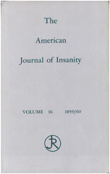Laboratory response of patients with panic and obsessive-compulsive disorders to 35% CO2 challenges
Abstract
OBJECTIVE: The DSM-III-R anxiety disorders section includes both panic disorder and obsessive-compulsive disorder. To evaluate the relationship between these two disorders, subject responses to inhalation of a 35% CO2 and 65% O2 mixture were assessed. METHODS: Twenty-three patients with panic disorder, 23 with obsessive-compulsive disorder, 12 with both obsessive-compulsive and panic disorder, and 23 healthy comparison subjects were given a single vital capacity inhalation of 35% CO2 and 65% O2 or a placebo mixture of compressed air. A double-blind, random, crossover design was used. RESULTS: Patients with panic disorder and patients with both panic disorder and obsessive-compulsive disorder showed similar strong anxiogenic reactions to 35% CO2; while patients with obsessive-compulsive disorder alone did not differ from comparison subjects. CONCLUSIONS: These results confirm that obsessive-compulsive disorder and panic disorder are two distinct syndromes and that patients with these disorders have different sensitivity to CO2 inhalation.
Access content
To read the fulltext, please use one of the options below to sign in or purchase access.- Personal login
- Institutional Login
- Sign in via OpenAthens
- Register for access
-
Please login/register if you wish to pair your device and check access availability.
Not a subscriber?
PsychiatryOnline subscription options offer access to the DSM-5 library, books, journals, CME, and patient resources. This all-in-one virtual library provides psychiatrists and mental health professionals with key resources for diagnosis, treatment, research, and professional development.
Need more help? PsychiatryOnline Customer Service may be reached by emailing [email protected] or by calling 800-368-5777 (in the U.S.) or 703-907-7322 (outside the U.S.).



